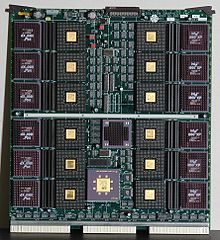RealityEngine


RealityEngine refers to a 3D graphics hardware architecture and a family of graphics systems that implemented the aforementioned hardware architecture that was developed and manufactured by Silicon Graphics during the early to mid 1990s. The RealityEngine was positioned as Silicon Graphics's high-end visualization hardware for their MIPS/IRIX platform and was used exclusively in their Crimson and Onyx family of visualization systems, which are sometimes referred to as "graphics supercomputers" or "visualization supercomputers". The RealityEngine was marketed to and used by large organizations such as companies and universities that are involved in computer simulation, digital content creation, engineering and research.
It was succeeded by the InfiniteReality in early 1996, but coexisted with it for a time as an entry-level option for older systems.
RealityEngine
The RealityEngine was a board set comprising a Geometry Engine board, one to four Raster Manager board(s), and a DG2 Display Generator board. These boards plugged into a midplane on the host system.
The Geometry Engine was based around the 50 MHz Intel i860XP.
VTX
The VTX was a cost-reduced RealityEngine and as a consequence, its features and performance was below that of the RealityEngine. It is not the VGX or VGXT board set.
RealityEngine2
The RealityEngine2, branded RealityEngine2, is an upgraded RealityEngine with twelve instead of eight Geometry Engines introduced towards the end of the RealityEngine's life. It was succeeded by the InfiniteReality in early 1996.
It uses the GE10 Geometry Engine board, RM4 Raster Manager board and DG2 Display Generator board.
References
- Akeley, Kurt. "RealityEngine Graphics". Proceedings of SIGGRAPH '93, pp. 109-116.
